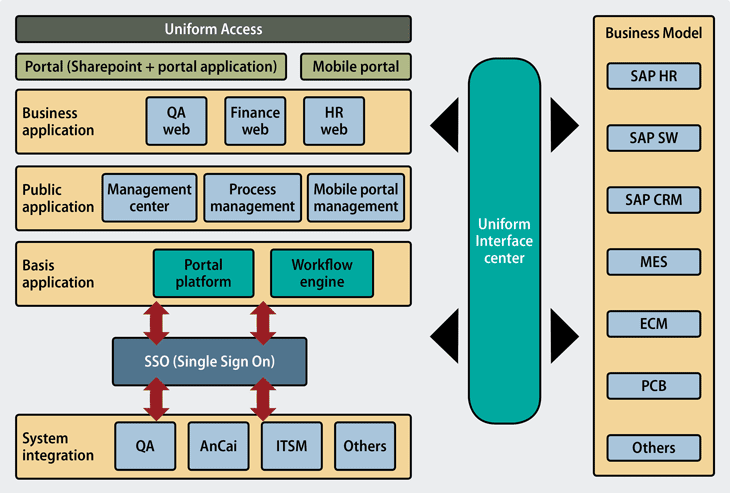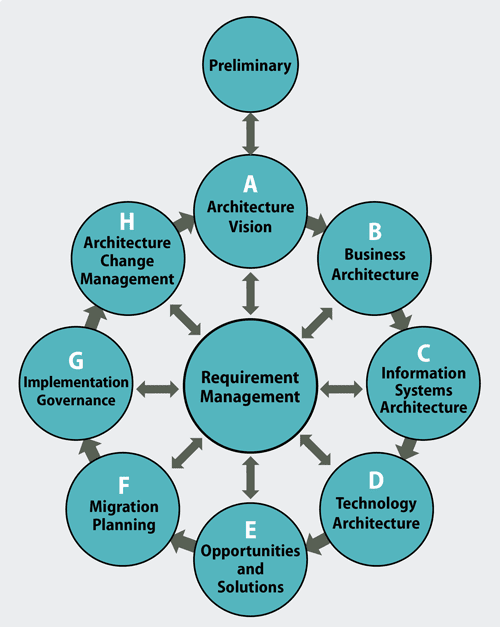Datamation content and product recommendations are editorially
independent. We may make money when you click on links to our
partners.
Learn More.
At the simplest level, IT professionals use the phrase “enterprise architecture” to describe the overall blueprint for a large organization’s IT systems. For example, they might say, “Our company’s enterprise architecture is multicloud (or hybrid cloud, private cloud or public cloud).”
Some organizations have a slightly more formal approach to the concept. For them, enterprise architecture refers to an actual set of diagrams or charts that shows how the different pieces of an organization’s IT systems work together. Commonly, it might show how information flows between a data center and whatever cloud company provides a remote platform.
But many organizations have a much deeper understanding of enterprise architecture. For them, enterprise architecture encompasses not only IT but also business process. Historically, this was the meaning of the phrase when it first came into use in the 1980s. Early enterprise architecture frameworks tracked data, functions, networks, people, time and motivation in regards to both business processes and technology.
And for some organizations, enterprise architecture is not just a description of the current state of things, but a process for improving the way the company works. For them, enterprise architecture is about moving from a current state to a future, more desirable state.
This broad definition of enterprise architecture might support goals related to optimization, cost reduction, data analytics, artificial intelligence, speed to market, risk management and, especially, aligning business and IT. Vendors who sell enterprise architecture products and services and consultants who offer business advice are generally using this meaning when they speak about enterprise architecture. Clearly, this is the definition that offers the greatest potential benefit for organizations.

In a typical example of enterprise architecture, all elements are included in the overall schema, from business models to business applications to system integration workflow.
Featured Partners: IT Software
Benefits of Enterprise Architecture
Proponents of enterprise architecture say that it offers many advantages, particularly when used as a process for implementing digital transformation. Some of those benefits include the following:
- Aligning business and IT — In the best of worlds, enterprise architecture helps organizations create an IT infrastructure that suits their business goals. Without this practice, companies are sometimes unable to translate their strategy into clearly defined processes, procedures and technology requirements. Advocates often point to this as one of the key benefits of enterprise architecture.
- Management of complexity — In today’s hybrid cloud and multicloud environments, IT systems are more complex than ever before. Defining your enterprise architecture allows you to gain a comprehensive view of the entire ecosystem and, potentially, make changes that optimize your infrastructure.
- Improved agility — Enterprise architecture allows companies to break down silos within their organizations and see the big picture. That makes it easier to introduce changes like service-oriented architecture (SOA), microservices architecture, DevOps and others.
- Better governance — Shadow IT has become a real concern as today’s employees find it all too easy to spin up cloud computing instances as needed. But this ad hoc use of systems may cause companies to run afoul of their own policies or regulations like GDPR. Defining your enterprise architecture can help you better understand what is running on your systems and whether you are meeting your compliance goals.
- Reduced costs — In theory, enterprise architects should help organizations optimize and prioritize their spending, reducing costs on items that are secondary to key business goals. In practice, however, these benefits haven’t always materialized.
Challenges of Enterprise Architecture
Enterprise architects have come under substantial criticism for failing to meet their promised goals. Government enterprise architecture projects, in particular, have sometimes been held up as prime examples of failed IT initiatives. Some of the key issues include the following:
- Expense — If they don’t have a carefully defined budget, enterprise architecture projects can cost more than they save. For example, several government enterprise architecture projects carried price tags in the millions of dollars. However, advocates say that today’s new enterprise architecture software helps keep the expense from getting out of control.
- Time — A big part of those costs is the hours of labor that workers must put into the projects. And some projects stretch on for years as architects struggle to make sense of complicated and constantly changing systems and processes.
- Lack of flexibility — Some of the enterprise architecture frameworks have come under fire for being too rigid and inflexible. They may not meet the needs of every organization. However, advocates say that hiring a knowledgeable enterprise architect can help overcome inherent flaws in chosen frameworks.
- Lack of effectiveness — Many organizations abandoned earlier enterprise architecture project because they didn’t meet the original goals for the initiatives. However, some analysts are noting a resurgence in interest in enterprise architecture, this time with better-defined objectives and metrics. That has led to an increase in enterprises hiring enterprise architects.
What is an Enterprise Architect?
In the simplest terms, an enterprise architect is an IT professional hired to oversee a company’s enterprise architecture.
But because organizations have differing definitions of what enterprise architecture is, the responsibilities that go along with this job function can vary widely. In fact, if you search on a job board for enterprise architect jobs, you’ll find quite a lot of differing approaches.
Some of the companies are looking for a technologist who can help make decisions about whether to use a cloud service or an in-house data center. And some have job requirements that might more accurately be described as an application architect or a data architect or a security architect; these requirements are narrowly focused on one aspect of the organization’s IT infrastructure.
Other companies are looking for someone with more holistic capabilities to help them better align business and IT. Often these positions are part of an ongoing digital transformation initiative that has a goal of helping the organization become more agile.
And some businesses are looking for job candidates with knowledge of and experience in a particular type of enterprise architecture framework – along with a deep focus in, say, security or AI.

Planning enterprise architecture requires balancing a wide variety of governance, technology and management issues.
Enterprise Architecture Frameworks
An enterprise architecture framework is a model that organizations use to help them understand the interactions among their various business processes and IT systems. Over the years, people have developed literally dozens of different frameworks, some of which are designed for a particular niche type of organization.
Often, these frameworks view enterprise architecture in terms of layers. For example, they might have a business layer, an application layer and/or a data layer. Many of these frameworks also incorporate formal processes for improving enterprise architecture and transitioning from a current to a future state.
Some of the most common enterprise architecture frameworks include the following:
- Zachman Framework — First proposed in a 1987 article in the IBM Systems Journal, the Zachman Framework was one of the earliest examples of an enterprise architecture framework. It arose out of the work of John Zachman, who worked for IBM, and it has been updated several times. It organizes enterprise artifacts — that is, all the various parts of the enterprise — onto a two-dimensional grid, usually six-by-six.
- NIST Enterprise Architecture — Developed by the U.S. government’s National Institute for Standards and Technology, the NIST Enterprise Architecture framework also dates back to the late 1980s. It uses a five-layer model that includes business architecture, information architecture, information systems architecture, data architecture and data delivery systems. NIST intended it to be used by all U.S. government agencies.
- TAFIM — The U.S. Department of Defense was one of the earliest users of an enterprise architecture framework, and it created the Technical Architecture Framework for Information Management (TAFIM) in the 1980s and 1990s. This lengthy guide included an eight-volume manual and cost many millions of dollars. It included a seven-phase planning process and an integrated model of four architectural views. Although the project was eventually cancelled, it was very influential in the creation of other enterprise architecture frameworks.
- EAP — Steven H. Spewak, one of the first professional systems architects, proposed the Enterprise Architecture Planning (EAP) model in 1992. It focuses on enabling change and includes four levels: getting started, where we are today, the vision of where we want to be, and how we plan to get there. It became the basis for several other enterprise architecture frameworks.
- TOGAF — Short for “The Open Group Architecture Framework,” TOGAF is the product of work done by an industry standards organization and is based on an earlier framework created by the Department of Defense. It is one of the most popular enterprise architecture frameworks in use today. It has a circular structure with eight key sections and four architecture domains.
- FEAF — The Federal CIO Council first introduced the Federal Enterprise Architecture Framework (FEAF) in 1999. The U.S. government later dramatically revised FEAF in 2013, and it is now the standard for U.S. government agencies. Many of its characteristics are mandated by law. It includes six reference models: performance, business, data, application, infrastructure and security.
- FDIC Enterprise Architecture Framework — Like the NIST framework, the FDIC Enterprise Architecture Framework was developed by a government agency, in this case, the Federal Deposit Insurance Corporation. It also has a very similar triangle structure with five layers but those layers are slightly different: business, information, data, applications and technical infrastructure.
- DoDAF — Based on work from the 1980s and 1990s but not released under this name until 2003, the Department of Defense Architecture Framework (DoDAF) continues to be a popular framework for use in highly complex environments. Like the TAFIM, it is an extremely long document — around 300 pages. It incorporates seven different viewpoints: systems, services, data and information, capability, project, operational, and standards.
- Gartner/Meta — Analyst firm Gartner has its own proprietary enterprise architecture framework which incorporates work done by Meta Group, which Gartner acquired in 2004. The company hasn’t publicly released many details about the framework, but it describes the framework as “a multiphase, iterative, nonlinear model focused on enterprise architecture process development, evolution and migration, along with governance, organizational and management subprocesses.”
Enterprise Architecture Products and Services
Many different vendors offer products and services designed to help organizations define and improve their enterprise architecture. Interestingly, most of the software vendors tend to be smaller companies that focus primarily on enterprise architecture, while many of the service providers are larger, more well-known enterprises. Some of the most notable from both categories include the following:
Enterprise Architecture Software Vendors
- Erwin Enterprise Architecture
Enterprise Architecture Service Providers
SEE ALL
DATA CENTER ARTICLES 


